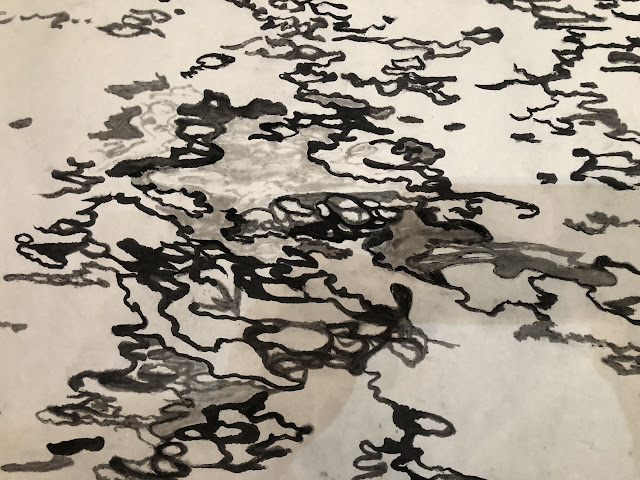I kind of missed my yellow mountain piece after I toyed with it by adding a rising sun. Perhaps I should settle down and work on another landscape painting; one that is more "classical".
Of course that is just me mumbling to myself. I am not sure I fully understand the word "classical". Can I reduce it to the simplest term, something that reminds me of the past?
I am reminded of the days when I was a student of Chinese brush painting and the hours spent in repeating and emulating everything that was in Mustard Seed Garden, hoping to my my work look "authentic" by being "classical". Aside from the different brush techniques, I also learned the doctrines in classical landscape paintings, and one of those deals with perspective. Scattered focal point is one thing, but more interestingly is the 3 perspective in the composition. I am not referring to anything remotely related to say the vanishing point perspective. Specifically the perspectives that govern landscape painting are the height perspective, the depth perspective and the level perspective.
Height perspective is as it suggests, the perspective of dealing with height, how the viewer is to perceive altitude. Hence the peaks have to be soaring, and cliffs precipitous. The so called "level" perspective is actually what we would construe as the depth perspective; how to distinguish near objects from objects that are farther away. Our depth perspective actually describes what goes on from near to far. In other words, the painting needs to show not only the relative distance between objects, but how these objects are linked. By placing person pushing a cart on a trail around a bend going behind a hill is a good example of our "depth perspective". The artist fabricates an event or story line that directs the viewer's attention from foreground to background. I personally deem this the most unique thing about "classical" landscape painting.
Certain requisite features are often present in a "classical" landscape. One will almost always find boulders, hills, mountains, streams, water, mist, waterfall, outcrops dotting the scenery. From there one sometimes can see incidentals like shacks, vessels, foot bridges, animals etc. A flat platform is sometimes included to add interest. I was taught dots form lines, and lines form planes. So the ability to describe a plane, often sitting on top of a precipitous is one way to showcase the artist's proficiency. This is no different from a pianist or violinist demonstrating their virtuosity when playing the cadenza during a concerto.
Yes, there are indeed a lot of things to look for when enjoying a classical landscape painting. And yes, it can be quite pedantic.
I often grabble with the notion of a contemporary painting "classical" landscape because somehow I identify that as the product of rote learning and one is just regurgitating what someone did years ago. I certainly understand that some of the "classical" landscape is impressionistic and full of symbolism, that the peak is the emperor and he is adorned by his subjects. Nonetheless I would prefer us contemporary practitioners painting something real and that people can relate to, or moved by, as well as being beautiful.
Having said that, my assignment for myself, my so called "classical" landscape, shall adhere to the things I've learned as a student ( most of it anyways) and still harbor a bit of truth, as in real landmarks?
More aptly, I am borrowing a "classical" setting to house modern day landmarks.
I hark back to my trips to Taiwan, a couple of places in particular, that could fit into my landscape painting. One of those places is Jiufen ( Jiufen Old Street) and the other is the Sun Moon Lake, where Ci En Pagoda is located.
This is a photo I took of a temple by the bus stop up by Jiufen.
and this is a photo of the Ci En Pagoda at Sun Moon Lake,
A common format of Xuan paper has the 2:1 ratio, the height being twice the width. So I am loosely following this particular format. I am painting on the Cicada skin Xuan. It is more forgiving with my less than stellar techniques.
I am putting the temple from Jiufen in the foreground, and the Pagoda in the middle ground, and the background shall be a continuation of the mountain range.
I am using the classical ways to paint trees and shrubs, as depicted by the venerable Mustard Seed Garden. I am leaving a lot of spaces between my different objects. My intention is to fill in with leaves and dots. Something impressionistic and spontaneous, to break up the solemnness of a "classic".
I am placing tall trunks on the paper for my trees. They could be lodge pole pines or firs, but for now they appear more birch-like. Oh well, that's not important. I've done such tall trees in my Multnomah Falls paintings, and trees are abundant in the Pacific Northwest, so that's something I can relate to. For heaven's sake, I was once employed by a plywood mill.
I have included a flat platform with a trail at the bottom. I am a good student. But seriously, that footpath is my adherence to the depth perspective. The viewer's attention shall, hopefully, follow that path to somewhere behind the foreground, and attempt to imagine "what's behind that."
Making it real now, coloring the temple, using my photo as reference.




















































